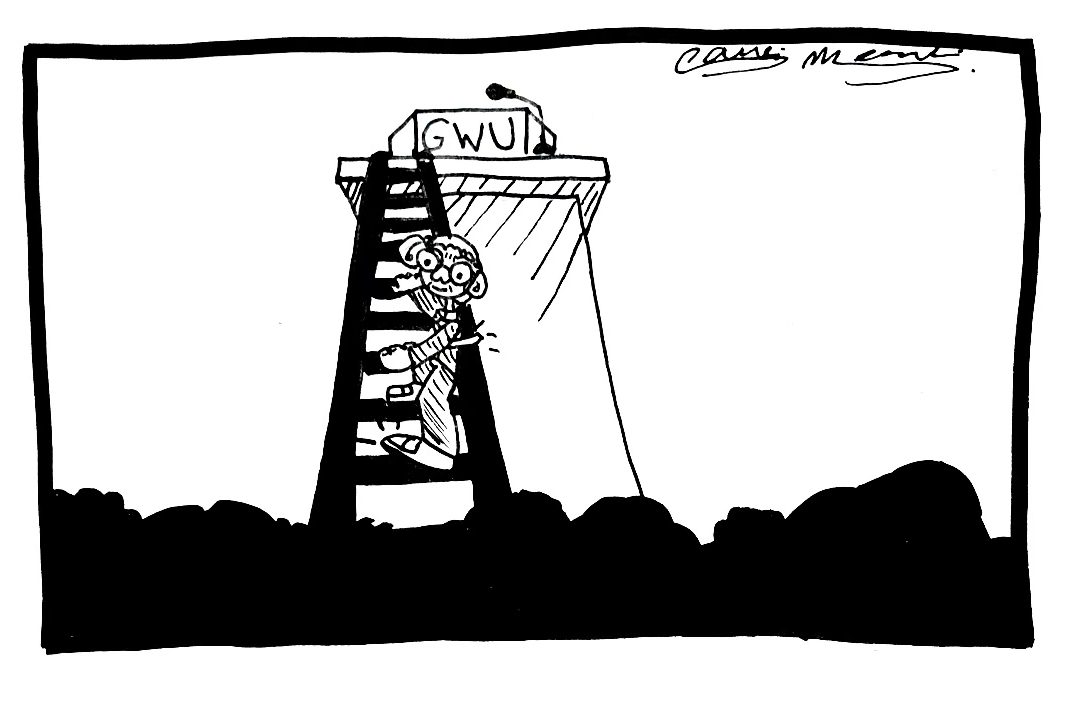It was only the second Shabbat dinner of this semester when a friend shared an episode that prompted me to write this piece. I hear these kinds of stories all the time – but really? Classes had started just two weeks before he told about this disheartening incident.
My friend was walking out of class with one of his peers. Both were Jewish. One of them carried a backpack with a pin bearing Hebrew and Israeli symbolism. From behind they heard two other students obnoxiously say, “Stupid Zionist.” The boy carrying the backpack turned around. “Yes, I’m Jewish, I’m a Zionist. Is there a problem?” The offending student replied, “Yeah, you’re going to hell.”
But this incident is far from a one-time occurrence. Chabad GW’s rabbi told me that in all of his years at GW, he has never felt such antisemitism before – “It’s chilling. I can feel it in my bones.”
Nothing is done about it.
At a school that is whose student body is more than a quarter Jewish as of 2020, and has the fourth highest percentage of Jewish students on a private college campus nationally as of 2018, I was astonished by the statistics of antisemitic misconduct at GW. In a report from Jewish on Campus, the central anti-antisemitism advocacy platform for colleges, students at GW reported 25 antisemitic incidents on GW’s campus in 2020, falling just below New York University, which reported 30 incidents.
To extinguish, or even reduce these flames of hatred, we must know the roots, causes, components and consequences of antisemitism. The Office for Diversity, Equity, & Community Engagement and Orientation programers must acknowledge that Jews face systemic discrimination and bring antisemitism into the conversation at GW.
Awareness is the first step to combatting indifference. The statistics above demand the inclusion of antisemitism in the diversity, equity and inclusion, Title IX and AlchoholEDU trainings we complete online and in person during orientation. Its absence in the first place is deeply troubling. While the ODECE provides several links on its website about antisemitism, they are not publicized, discussed or personalized in student programs or classes. During freshman orientation – both online and in person – I listened to numerous student testimonials, none of which mentioned Jews in any capacity. As of 2019, the ODECE did claim that they would “continue to evolve the curriculum based on the campus and national climate.” With the rampant rise of antisemitism and curriculum remaining stagnant, something seems off here. If we are taught to step in when we witness discrimination, shouldn’t Jews be also advocated for, not unlike any other group we do so for on campus?
I’ve been passionate about combating injustice from a young age, a value founded on the Jewish principle of Tikkun Olam, repairing the world. I’ve created a curriculum for my high school keystone project on the ADL/No Place for Hate platform — it is a nuanced version of a 2021 USC Edge Center award-winning curriculum that I co-authored with my mother. It fuses the importance of diversity and tolerance, the eight stages and warning signs of genocide and tools like methods of communication that you can employ to counteract hate. Diversity and Orientation programmers should consider drawing on the ideas laid out in these sources for upcoming online and in-person modules with Jews included in the conversation.
Examining the sources of intolerance toward minority groups begins with understanding the perspectives of ignorance and hatred. All students, administrators, faculty and staff must learn and recognize what constitutes antisemitic misconduct – there are different denotations and connotations of ‘antisemitism’ and ‘anti-Zionism,’ but conclusively, opposing the survival of a religious or ethnic group is blatant discrimination. There’s nothing wrong with criticizing Israeli politics and policies – the line is crossed when one denies Israel’s right to exist. Our communities must understand that the safety of the Jewish people is not secure without it. Just 80 years ago, six million of us were slaughtered for no other reason than being who we are. This must be taught as fears of a similar fate survive to this day. Hate speech is the first step to genocide: This hatred – “You stupid Zionist. You’re going to hell” – persists unabated.
Integral to my college decision was selecting a school with a significant Jewish population and vibrant Jewish life – we are fortunate to have both at GW. I may be a naive freshman who believed that this large identity pool would filter out antisemitism, at least to some degree. I may have assumed that being proudly Jewish – proud of my values and traditions, proud of the country that secures the survival of my ethnicity – would be respected and possibly admired. Sadly, it’s quite the opposite. “It’s so weird being Jewish here. It feels odd,” my friend confided in me. We are limited in embodying our identity on campus. We fear being disliked, canceled and bullied for who we are. This muzzle on our authentic expression is exactly why, as my friend said, “being Jewish here” feels rather “weird.”
I hear administrators, staff, professors and students preach diversity, inclusion and equality all day long, whether in orientation, online modules, lectures or discussions. These words, however, ring hollow when Jews are not even mentioned in these conversations. Holocaust survivor Elie Wiesel notably said in his Nobel Peace Prize speech that “neutrality helps the oppressor, never the victim.” Indifference indeed begets hatred. Indifference is bred when education is absent or falls short.
Enlightening our community with this stark reality is the first step to bringing about change. Awareness fosters care, care sparks passion and passion often turns to action.
We must live by the words of Holocaust survivor Gussie Zacks, whom I interviewed two years ago conducting Holocaust research for National History Day competitions. She told me, “Learn, be active, do something.” This is how we all must live, but we first need education.
Sabrina Soffer, a freshman majoring in international affairs, is an opinions writer.


